Culinary Training
Top Schools
- Culinary Arts Schools
- Le Cordon Bleu
- The Art Institutes
- Kitchen Academy
- Johnson and Wales
- International Culinary Center
Majors
- Culinary Majors
- Culinary Arts
- Baking & Pastry Arts
- Food Prep/Prof. Cooking
- Hotel & Restaurant Management
- Culinary Arts Management
- Wine, Spirits & Beverage Management
Degree Types
Career Information
Health
Fun
Calculate Your Tip & Estimate Your Share of the Check


A History of Tipping in the United States
Tipping in restaurants has been a long-time custom in the Unites States. If you've ever worked in the food service industry, you'll know how tips are crucial for boosting your earnings.
Giving tips is a hallmark in American dining that rewards excellent work. As a common practice, diners give higher tips to waiters if they are happy with their service. Likewise, if it needs improvement, they give a lower amount. Some customers even give tips in advance to ensure prompt service.
Tips are said to reflect the customer's level of satisfaction while functioning as an incentive to maintain quality service. However, there are restaurant owners that think otherwise. And with recent changes in the food industry, notably due to the Covid-19 crisis, many restaurants are forced to come to terms “the new normal.”
In this guide, we'll look into a brief history of tipping culture in the US, general restaurant failure rates, and how Covid-19 has greatly impacted different food businesses.
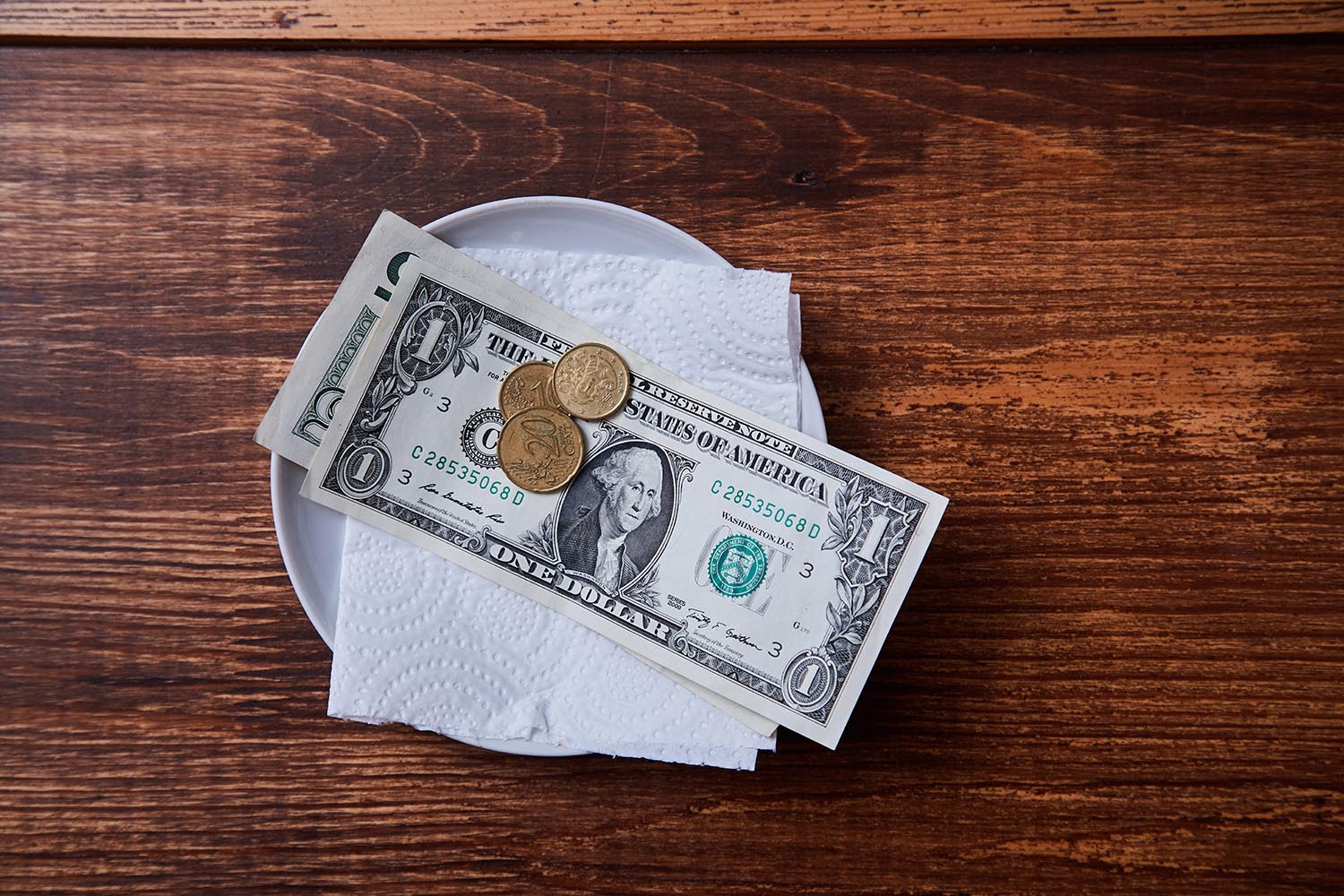
Though tipping in restaurants is the norm in America, this wasn't always the case. The custom was first practiced in feudal Europe and brought to America around the late 1800s.
Tipping started right after the American Civil War in 1865, states Michael Lynn, a professor from the Cornell University School of Hotel Administration.[1] He suggests that affluent Americans who traveled to Europe picked up the elite custom and brought it back to America. According to Lynn, they perhaps did this to flaunt their social standing and level of education.
In a related article by Business Insider, “tip” may have began as an acronym which means “To Insure Promptitude.”[2] Though it's exact history is uncertain, tipping can be traced as far back as 17th century England, where the acronym was written on serving bowls inside coffeehouses. The practice may have even began in British taverns where drinkers would slip money to get priority service.
When tipping came to America, it wasn't always widely accepted by everyone. A New York Times feature states that in 1987, the publisher claimed “many thought it was antithetical to American democratic ideals.”[3] The article also mentions how another periodical frowned upon tipping for creating a sector of workers that are “financially dependent” on the richer class.
The New York Times highlights major events which demonstrated the anti-tipping movement:
- Many labor Unions and traveling salesmen supported anti-tipping campaigns.
- In 1904, 100,000 members of the Anti-Tipping Society pledged not to give tips for a year.
- In 1909, the state of Washington became the first state to pass an anti-tipping law. Six other states followed
- In 1909, Washington became the first of six states to pass an anti-tipping law. Other non-tipping states included Mississippi and Arkansas. Anti-tipping laws were passed in 1915 in the states of Iowa, South Carolina, and Tennessee.
- By 1916, author William Scott wrote The Itching Palm, a book that strongly criticized tipping as a practice that encourages “a servile attitude for a fee.”[4] Scott decries tipping because he doesn't believe in paying for a service twice (for the employer and then for the worker).
Meanwhile in Europe, the British were peeved by wealthy Americans who ruined tipping rates by giving too much gratuity, according to an article by the National Public Radio (NPR).[5]
Europe also began to reconsider their tipping custom for fairer wages. By 1943, the Catering Wages Act of Britain mandated a minimum wage for service worker to help ease their dependence on tips. And around 1955, France instituted a rule that obligates restaurants to include a ‘service compris' or service charge to every receipt. This, for the most part, has become the practiced custom in Europe.[3]
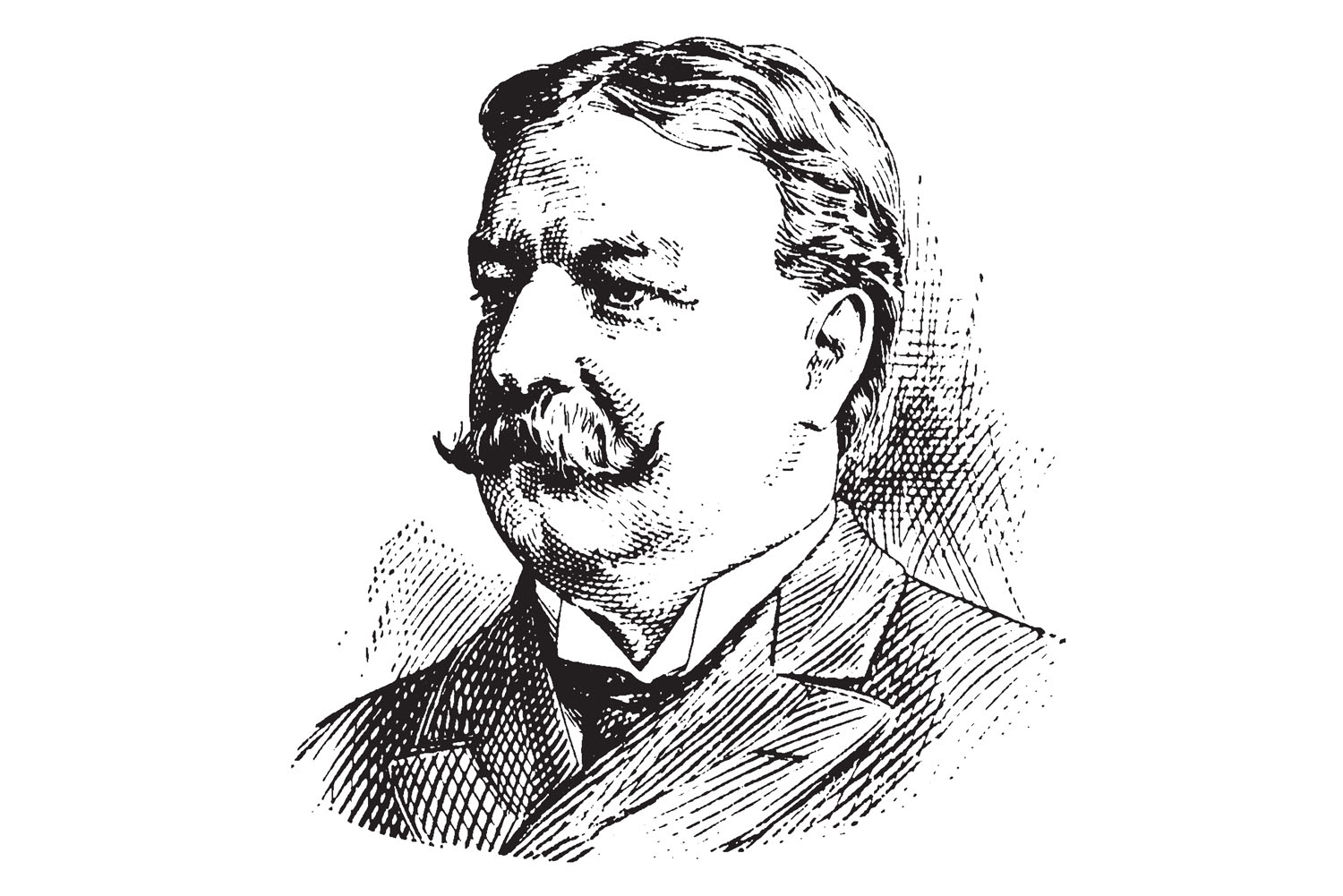
NPR included a rundown of prominent personalities who opposed tipping. Some of these personalities include:
- William Howard Taft – When Taft ran for president in 1908, he was dubbed “the patron saint of the anti-tip crusade.” Taft was known to take pride over never tipping his barber.
- Ralph Waldo Emerson – Emerson admits that he sometimes gives tips, but considers it “a wicked dollar.”
- Mark Twain – Twain was known for refusing to tip a cab driver after a periodical praised him for not complying with the custom in 1901.
- Andrew Carnegie – Despite being a wealthy industrialist, Carnegie is said to be quite a stingy tipper. Like other anti-tippers, perhaps he wouldn't give tips if it weren't the norm.
The Disappearance of the Anti-Tipping Movement
So what happend to anti-tipping in America? By the 1950s, most anti-tipping movements have all but dissipated in the restaurant culture. Despite great opposition from detractors, giving tips persisted in the US.
Ultimately, it's hard not to comply with tipping when many restaurants have made it the norm. Even the president of the American Federation of Labor, Samuel Gompers, said he also adhered to the custom.
If establishments don't ban it, nothing really stops employees from soliciting tips. By around 1926, all anti-tipping laws were revoked in the country.[3]
Abolishing Tips in Today's American Dining
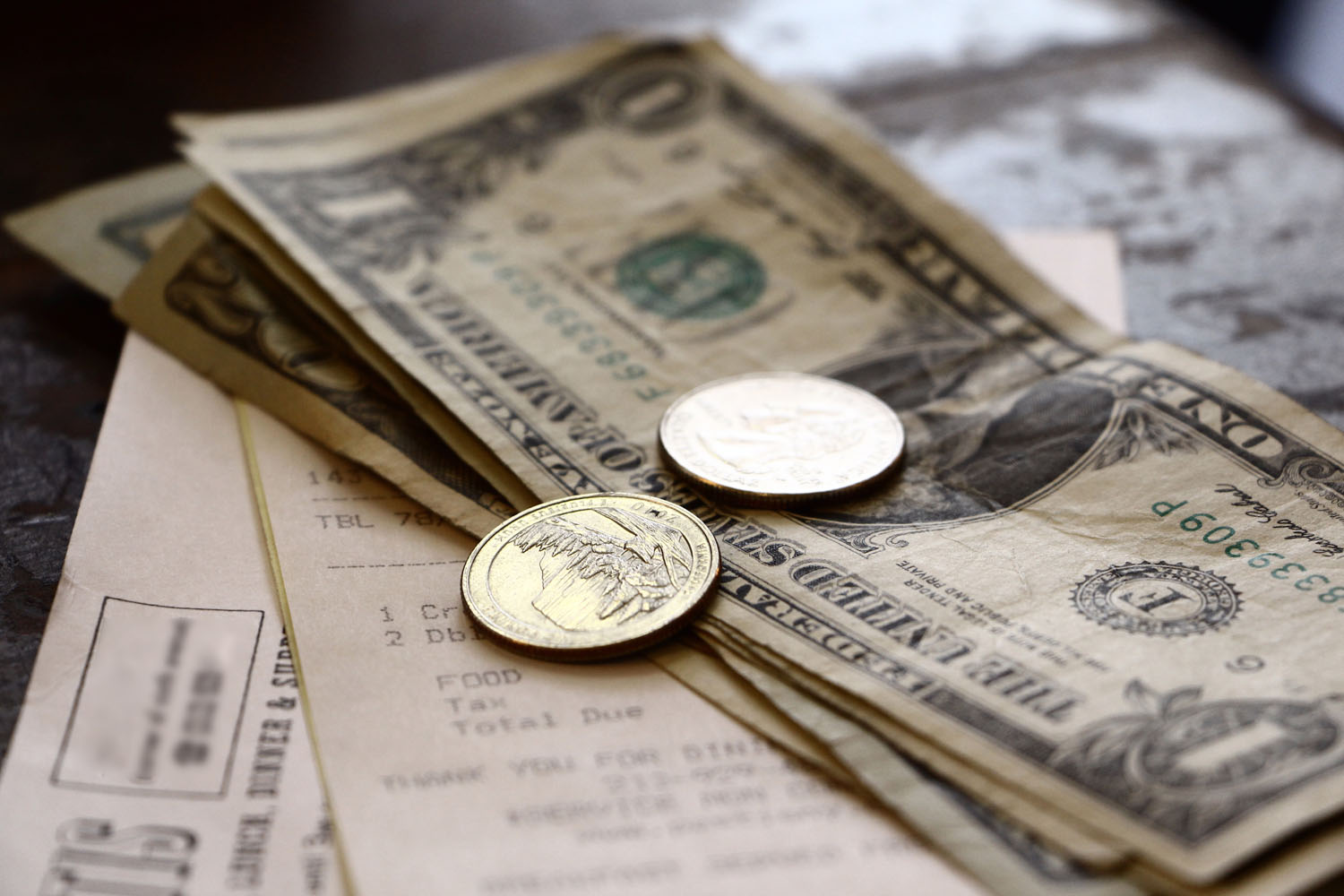
In recent years, though tipping remains prevalent, some business owners have decided to ban tipping in their establishments. These include New York restauranteur Danny Meyer, and Berkeley restauranteurs John Paluska and Andrew Hoffman.
In 2015, CEO Danny Meyer of the Union Square Hospitality Group decided to stop tipping in his restaurants. Meyer founded Shake Shack and popular New York restaurants called Gramercy Tavern and The Modern. According to NPR, Meyer said:[5]
I think that restaurant patrons have unwittingly believed that they could, if they wanted to, use their tip to punish bad service, and/or to praise great service. What that's done over the years has actually been quite the opposite, because the average American restaurant-goer leaves the exact same tip, irrespective of the service they receive. And unfortunately, none of those tips that you leave in a restaurant may be shared with the full team.
Danny Meyer
John Paluska, co-owner of Comal in Berkeley, seems to share the same sentiments with Meyers. According to TakePart magazine, that the widening wage gap between servers, bartenders, and kitchen staff is one reason why he wants to ban tipping.[6] Andrew Hoffman, Paluska's partner, also believes that paying their staff fair wages can affect their restaurant's profitability. Instead of passing that responsibility to consumers, they believe in giving higher wages instead.
But even when tipping is abolished, the pay gap between servers, cooks, and dishwashers remains difficult to bridge. Meyer states that in the last 30 years, a fine dining waiter's salary has increased by more than 200 percent, which is unfair compared to other restaurant staff. This can be due to increased food prices in restaurants (now with an average tip that's 21 percent higher compared to 1985). On the other hand, staff like cooks who don't get tips have only have an hourly wage increase of 22 to 25 percent.
Despite this reality, Meyer believes that their restaurant can shoulder the responsibility of paying all the staff by including everything in the menu prices. This, he believes, will provide better living wages for all food service staff.
What about the rest? Though some American establishments have banned tipping, the rest of the restaurant industry is yet to follow through. Since many food businesses run on really tight budgets, restaurant owners are reluctant to abolish tipping in favor of higher salaries. As a result, more food service workers still rely on tipping as a means to bolster their wages.
What are People's Reasons for Tipping?

While tipping is commonly seen as a way to reward better service, there are other motivations behind this practice.
To get to the bottom of tipping motivations, professor Lynn studied tipping and published over 50 research papers on the topic. Even before fully researching the tipping culture, Lynn also worked his way through school by bartending and waiting tables.
In his 2016 interview with PBS News Hour, Lynn explained he found five main motivations for giving tips, which includes:[7]
- To avoid disapproval from the server
- As a way to show off
- To improve future service
- As a sense of duty
- A way to supplement the server's income and make them happy
People usually say their main motivation for tipping is to reward waiters for a great job. It's a way of expressing gratitude and a measure for service quality. But Lynn doubts this motivation. He states:
I find the relationship is so weak that it would be wrong to use tipping as a measure of service quality… when we ask people how much they tipped and how they would rate the quality of the service, less than four percent of the differences in tips left by different dining parties can be explained by their ratings of service quality.
Michael Lynn
So what's the real motivator for tipping amount? The driving force, Lynn explains, is the bill size. The total cost of your meal is more powerful in determining how much you'll tip, even if you had a great service. According to his findings, the amount of a meal accounts for around 70 percent of the differences in tip amounts given by customers. The remaining 30 percent can be attributed all the other reasons combined.

In other studies, the tipping custom is often used as an example of a principal-agent problem in economics. A principal-agent problem is a type of conflict that arises between an individual or a group and a representative that is acting on their behalf.[8] The situation often raises conflicts of interest on a representative, such as a waiter.
Under the principal-agent problem, according to Robert J. Graham's Managerial Economics for Dummies, compensation agreements such as tipping may boost an employee's effort if their salary is tied to their company's success.[9] But again, this explanation has been met with disagreement by research.
In an episode of Freakonomics Radio in 2013, journalist Stephen Dubner and economist Steven Levitt talked about how tip size in the real world does not strongly correlate with quality of service, or any other effects customers might expect.[10] In the said episode, they also invited Prof. Michael Lynn to explain his tipping studies on the show.
In one part of the episode, Levitt explains how he dislikes tipping and the idea of not knowing how much to tip, or what's a fair amount. Dubner, on the other hand, says he routinely tips people who work hard on the job, especially when they are not paid well. Both hosts agreed that tipping can be confusing and awkward when you don't know how much is a fair amount.
To help you estimate tips fairly, use the tip calculator on top of this page.
For people who find tipping uncomfortable, they would probably not tip unless it's the norm. Once people start tipping, it actually puts social pressure on everyone else to give tips. Most of the time, people give in to that pressure. And unless establishments actively ban tipping, nothing stops waiters from accepting them.
Lynn also mentions that if restaurants were to stop tipping and replace it with an automatic service charge, some people would likely still tip (on top of high prices, just like in some countries). This can happen for the very same motivations. Once more people start tipping, it will be hard for people to escape the social pressure of giving tips again.
The Impact of Attractiveness, Gender, and Race on Tipping

In a research submitted by Lynn to the Journal of Applied Sociology, he notes that servers earn larger average tips if they are attractive females, better service providers, and high self-monitors.[11] In relation to the Freakonomics episode, Dubner asked Lynn about how the attractiveness affects the tip size. Below is an excerpt from the show with Lynn's response:[10]
LYNN: Attractive waitresses get better tips than less attractive waitresses. Men's appearance, not so important.
DUBNER: Okay, and what about a waitress versus a waiter generally?
LYNN: Hard to say. In general, I would say that waiters get better tips from women than men. Waitresses get better tips from men than women.
DUBNER: And what about let's say among women, hair color? Blonde is better than brunette or red, or no?
LYNN: Yes, blondes get better tips than brunettes. Slender women get better tips than heavier women. Large breasted women get better tips than smaller breasted women. Surprisingly, at least in the studies I've done, women in their 30s get better tips than either younger or older women.
When Lynn puts it this way, he merely confirms biases for stereotypically attractive servers, specifically women. But it's also a sign of deep-seated social issues aggravated by the tipping culture.
In 2016, the Washington Post published a feature which pointed out many evident social problems aggravated by tipping.[12] Aside from being an ineffective form of incentive, tipping power relations expose women servers to harassment.
The article quotes Jay Porter, a former restaurant owner who banned tipping and published his observations on the Slate. Porter states that tippers are usually male, while 70 percent of servers are female.[13] He also mentions that the restaurant industry makes five times the average number of sexual harassment claims per worker. On top of this, tipping generates bad service for customers who are young or old, people of color, foreigners, as well as women.[14]
The Washington Post also interviewed anti-tipping advocate Sara Jayaraman, author of Forked: A New Standard of American Dining, which reveals the dark and overlooked history of tipping.[15] According to Jayaraman, tipping is actually a custom associated with slavery:
[W]hen tipping came to the United States, it had a real racial tinge to it, because, originally, the workers who earned tips were almost exclusively black workers—they were newly freed slaves… The restaurant industry, which was hiring newly freed slaves as tipped workers, really wanted the right to hire these workers but pay them next to nothing.
Sara Jayaraman
This frames tipping as a vestige of slavery that has silently persisted through labor. It could also be the basis for why the federal tipped minimum wage allows restaurants to pay as low as $2.13 per hour for tipped workers.
When asked if she thinks tipping will be abolished, Jayaraman seemed hopeful of the prospect. A few prominent industry leaders have reached out to her about eliminating tipped minimum wage. Congress has even introduced the bill in 2015, a law that's a hundred years in the making. When a serious discussion is put out there, she believes it's a sign of progress.
Countries Where People Are Not Expected to Tip
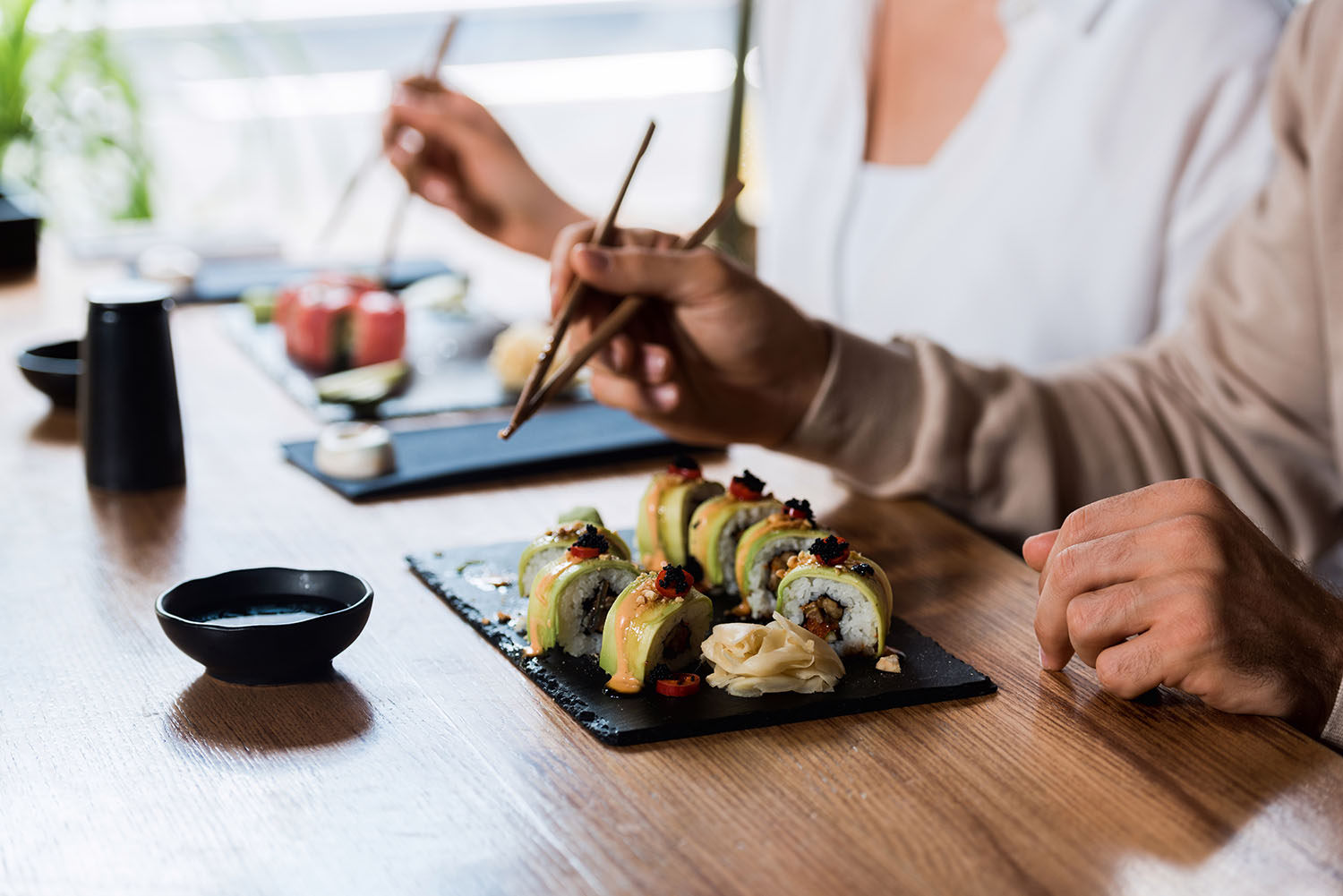
By now, some of you might be more uncomfortable about tipping. The good news is there are countries out there that don't impose this custom. It's also be interesting to learn how other cultures regard gratuity fees, whether it's not required but appreciated, or usually not accepted. According to Wise Bread, here are five countries that do not require tips:[16]
- Japan – Tipping is virtually nonexistent in Japan. Even if you try to give tips, you'll be met with a lot of confusion and awkward stares. Servers will simply give back your money, so don't argue about handing tips. Japan's culture is deeply rooted in respect and politeness. For them, good service is a standard that is done without expectation for extra tips.
- Switzerland – Customers are not obligated to tip for any service in Switzerland. According to their law, any service charge must be declared in your bill. Tips here are also limited to leftover change when you pay. Service workers are paid a high basic salary, which means waiters do not have to depend on tips to increase their earnings.
- South Korea – Leaving tips is also generally not required in South Korea. However, since it's home to a growing food and restaurant scene, some American-themed restaurants may still appreciate tips. Though edgy and modern, South Korean culture can still be quite traditional. Some restaurants may even regard tipping as a gesture of pity, which can really be embarrassing. To be safe, it's better not to tip.
- Brazil – Giving tips is not a common practice in Brazil. So there's no pressure to give extra to a bartender, waiter, or hotel staff. However, Brazilians sometimes give gratuity fees when they receive some type of special service. Otherwise, there is no real need for it. On top of that, restaurants automatically impose a 10 percent service charge on a bill.
- Denmark – Another country that puts a 10 percent service charge on your bill is Denmark. Just like Switzerland, service workers in Denmark receive ample compensation for their job. While tipping is not the norm, this practice seems more appropriate in fine dining restaurants where customers get special services. But even then, tipping is still not expected.
US Restaurant Industry Facts and Statistics
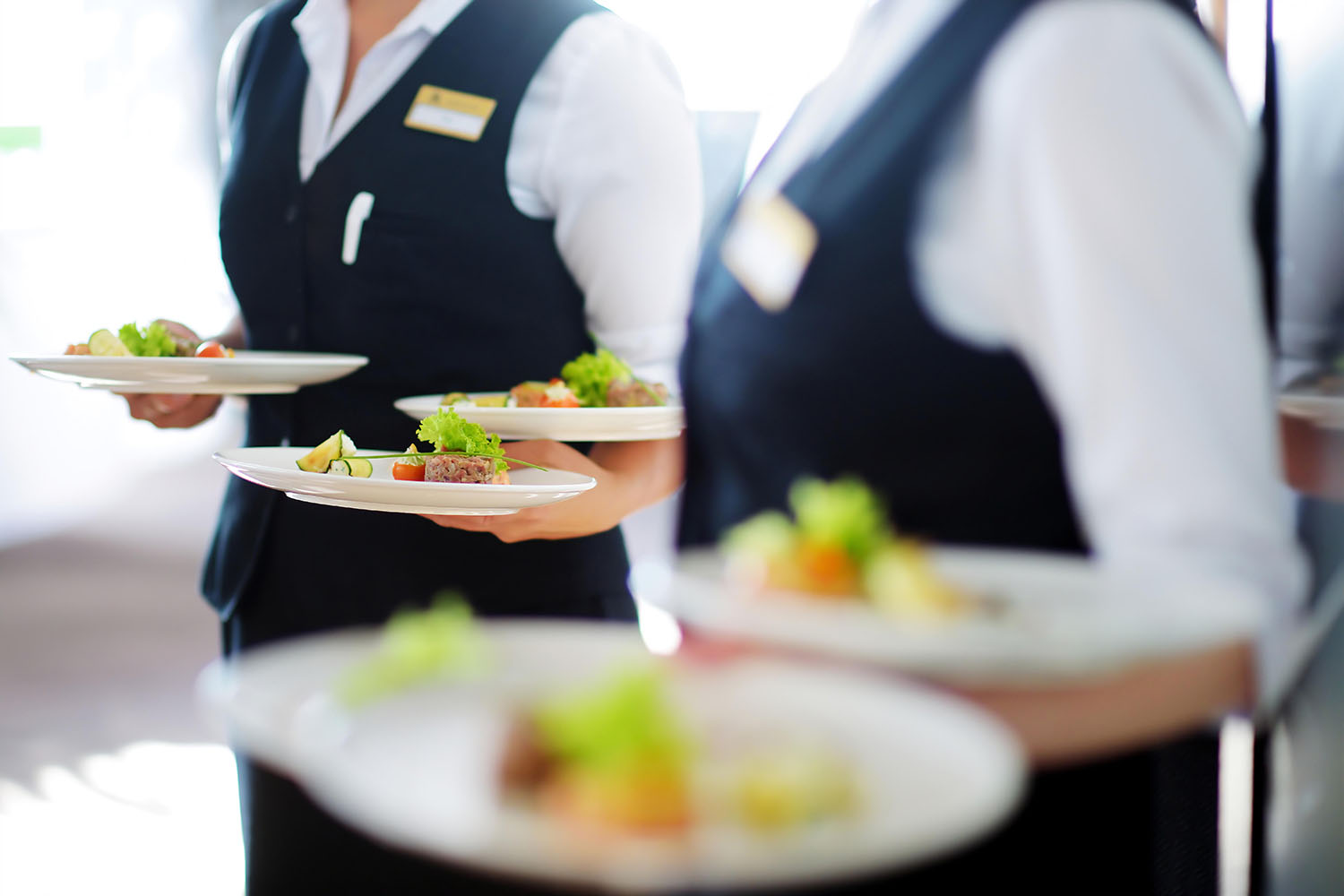
People who aren't familiar with the restaurant industry underestimate how tough it is to run food service. On average, around 60% of restaurants fail in their first year, according to a commonly cited study published in the Cornell Hospitality Quarterly. [17]
There are many factors that put restaurants down under, some of which include mismanagement of food costs, over-ordering supplies, and overlooking customer feedback.
But regardless of it's many challenges, restaurant businesses have seen considerable growth in recent years. Prior to the Covid-19 outbreak, the National Restaurant Association (NRA) compiled noteworthy statistics on restaurant services in 2020. See the data below:[18]
- There are 1 million+ restaurant locations in the US.
- Around 15.6 million employees worked at a restaurant, which employ more women managers and minority managers in any other industry.
- The number of middle-class jobs ($45K-$75K) in the restaurant industry increased to 84% between 2010 and 2018.
- Around 6 in 10 adults have worked in a restaurant at some point in their life.
- Restaurants are one of the top employers of teenagers, with 1 in 3 teens working in a restaurant.
- 9 out of 10 restaurant managers started in entry-level positions.
The total impact of the restaurant industry on the economy amounts to $2.5 trillion. Prior to Covid-19, it was expected to earn around $899 billion dollars in 2020. By 2030, the restaurant industry was projected to generate 1.6 million new restaurant jobs.
For studies about customers, below are NRA statistics on consumer trends:[18]
- 63% of consumers would rather spend on an experience (restaurant) than purchase an item.
- 58% of consumers state they are more likely to include restaurant-prepared items into their home-cooked meals than they were two years ago.
- 52% of consumers state that buying delivery or takeout food is essential to the way they live.
- 58% of consumers state they are more likely to have restaurant food delivered than they were two years ago.
- 61% of employed consumers state they are more likely to get takeout food on the way home than they were two years ago.
Based on these statistics, a considerable percentage of American consumers regard restaurant food as an integral part of their lifestyle. As for employment, it generates millions of jobs that bolsters significant growth in the economy. But with the impact of Covid-19 in the first quarter of 2020, the restaurant industry is seen to endure dramatic changes and massive loss in profits.
How Covid-19 Affected the Food Service Industry
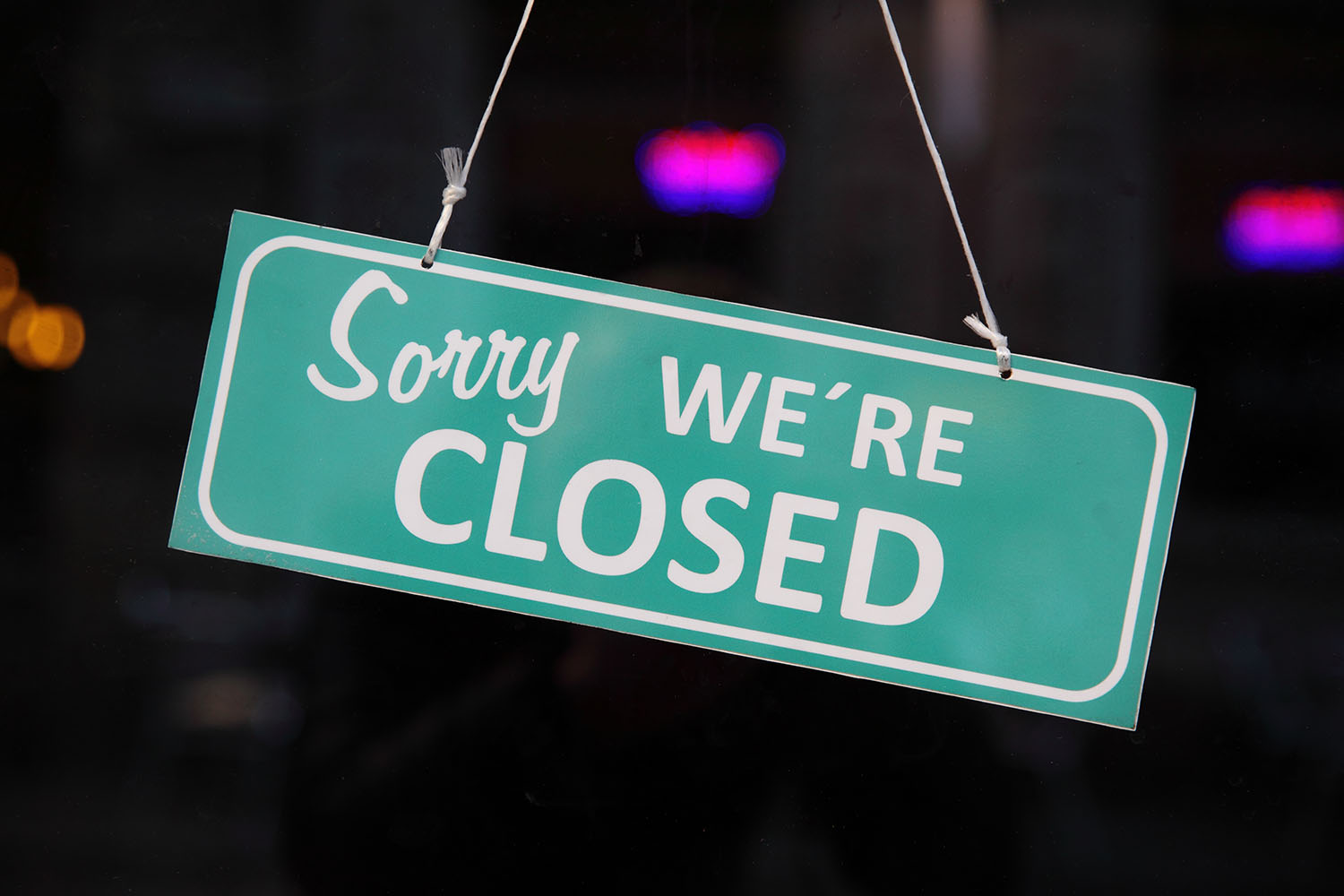
Since the first cases of Covid-19 were confirmed in February 2020, US restaurants have been struggling in various ways. Covid-19 (2019 N-Coronavirus) is a contagious and deadly virus that first began in China, and has ravaged countries all over the world.[19] As of May 22, 2020, there have been over 5 million confirmed Covid-19 cases worldwide according to the Johns Hopkins Coronavirus Research Center.[20]
Upon the outbreak, Business Insider reports that 40 US states were given stay-at-home orders, with only certain businesses allowed to reopen.[21] Other states, such as Washington DC and Puerto Rico, were given full lockdown policies to help prevent the virus from spreading. This brought a domino effect of temporary closures, company shutdowns, and mass layoffs for different businesses.
How has US employment rate changed since Covid-19? Below is a historic graph of the Employment-Population Ratio from FRED, between 2000 to May 2020.[22]
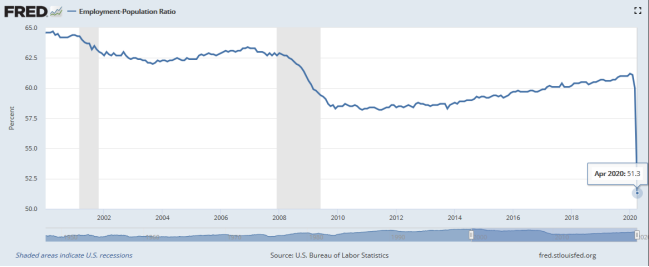
US Employment rate
- January 2020 – 61.2%
- February 2020 – 61.1%
- April 2020 – 51.3%
Based on the data above, you'll notice a dramatic decrease from 61.1% in February 2020, to 51.3% in April 2020. That's a drop of nearly 10% in employment rate.
In April 2020, PR Newswire reported that the restaurant industry lost more than 8 million jobs nationwide.[23] This was based on a survey of restaurant operators conducted by the NRA. In March 2020 alone, the restaurant and food service industry lost around $30 billion in revenue, with an estimated $50 billion more by the end of April 2020.
Darden Restaurant, Inc., the largest full service restaurant company in the world, is weathering the crisis. It owns popular restaurant chains such as Olive Garden, Yard House, and LongHorn SteakHouse. According to the Motley Fool, Darden Restaurant share price fell by 5% in May despite rising by 8% in three days.[24]
As many restaurants are closed, there is growing demand for takeout and delivery service. A number of restaurants are still operating for takeout or delivery, but this does not make up for the total loss of profits.
Amidst closure and unemployment, Forbes reported that Uber is set to buy out its main competitor, Grubhub, to widen it's food delivery services. This is seen as puzzling move during an economic crisis, but it seems Uber is willing to take the risk. The ridesharing company has since cut significant costs by laying off 25% of its employees and streamlining operations.
Restaurants are counting on people who will dine at their establishment once stay-at-home orders are lifted. But even then, restaurant dining will change due to social distancing measures which will likely be encouraged until further notice.[25]
Coronavirus Job Loss Impact on Women and People of Color

In May 2020, NPR stated that women are most affected by unemployment due to Covid-19. According to the report, women account for 55% of job loss in April 2020.[26] Women had an employment rate of 16.2%, while men's unemployment rate was at 13.5%.
Matthias Doepke, economic professor at Northwestern University, states that women's high unemployment rate shows that the 2020 recession is very different from economic downturns in the past. In previous recessions, male-dominated industries were usually hit hard, such as the housing crisis in 2008.
Doepke mentions that the highest job losses will occur in industries such as hotels, restaurants, and other hospitality sectors. He states that a long-term effect of the crisis may cause a wider gender wage gap.
In related news, Iowa Watch reported that certain states saw high shares of women's unemployment claims due restaurant closures. In the states of New Jersey, Virginia, and Minnesota, women were close to two-thirds of 267,000 new unemployment applicants in March 2020. This figure is 21 to 39 percent higher than average in the said states.[27]
Another alarming issue is the fast unemployment rate for people of color. Harvard Business Review states that in March 2020, unemployment rate for African-Americans rose up to 1.2%, while Asians and Hispanics experienced an increase of 1.6% in job loss. These figures are far higher compared to 0.9% unemployment rate in Caucasians. In total, unemployment rates for all racial demographics were as follows:[28]
- African-Americans – 7%
- Hispanics – 6%
- Asians – 4.1%
- Caucasians -4%
Another national poll by ABC News/Washington Post revealed identical trends, showing 37% unemployment rate for women, compared to 28% for men. Hispanics and African-Americans were also seen to have higher job loss rates at 40%, while Caucasians experienced lower rate of unemployment at 30%.[29]
Why are more women and minorities losing jobs? According to PEW Research Center, these trends probably emerged because women and minorities like African-Americans and Hispanics are disproportionately represented in jobs with high attrition rates.[30] This includes industries that focus on hospitality services, retail, manufacturing, and recreation.
How Does Social Distancing Affect a Restaurant?
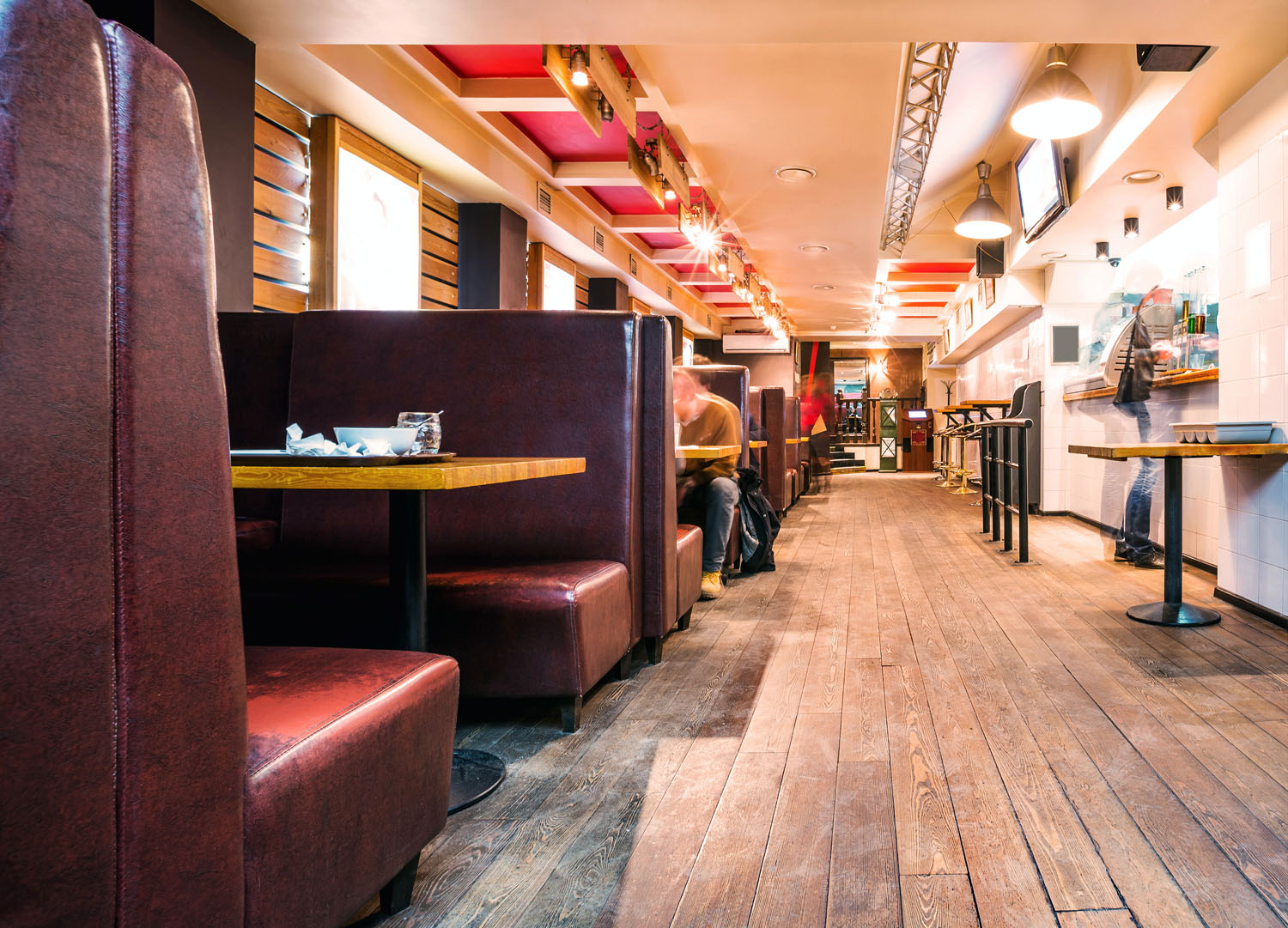
Many restaurants operate at such thin margins, forcing them to accommodate as many customers as they can to stay afloat.
But with social distancing rules in place, it will surely affect their operations. Unlike before, cafes and bars will not be able to serve as many patrons at a time due to the restriction. Customers who want takeout must line up at least 6-feet apart for safe distance. Needless to say, the “new normal” will dramatically decrease the volume and traffic of customers coming into their establishments.
A CNN article interviewed restaurant owners about their struggles during the health crisis.[31] Blaiss Nowak, a restaurant owner in Georgia, says that they will have no profits as long as social distancing is in place. He's also heard about many restaurants that will likely not open again. Restaurants in Georgia were allowed to reopen in April 27, 2020.
Below is a graph from CNN which illustrates customer rates in restaurants, specifically Texas and Georgia, before and after social distancing measures.
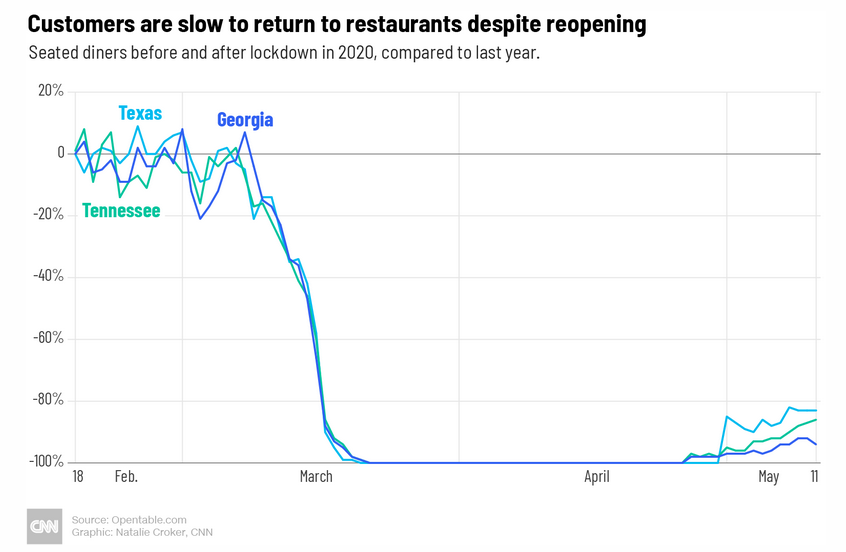
To comply with the new health rules, Nowak has limited his customers from 200 a night, to just 50 diners. The tables are spread 12 feet apart and their dining area only accepts 24 people at a time.
Before the health crisis, they used to accommodate up to 60 people at once. Nowak asserts that by reopening, his employees will be better trained in social distancing measures. This, he hopes, will make customers feel safe enough to return to his restaurant.
As evidenced in the graph above, only a fraction of people came back to restaurants in the start of May. Restaurants try to remain hopeful that their business will recover, but it seems the situation will likely take more time.
The Takeaway
Many social issues come to the fore by knowing the history of tipping in America. For one, it creates an environment where servers are more reliant on tips than minimum wage. Next, tipping is not the best incentive for employees to perform better.
The custom has also been associated with many harassment incidents and discrimination in restaurants. But the good news is, there have been efforts to proactively eliminate tipping for fairer wages.
However, after the Covid-19 outbreak in 2020, it seems tipping will be harder to abolish in the next 10 years. With massive lay-offs in the restaurant industry, servers who get to keep their jobs are probably looking toward earning more tips.
There's also a shift in more food delivery services due to stay-at-home policies. And as the food service industry recovers, it would likely take more time for America to ban tipping in restaurants.
Sources:
- https://www.foodwoolf.com/2010/08/history-of-tipping.html
- https://www.businessinsider.com/history-of-tipping-2015-10
- https://www.nytimes.com/2008/10/12/magazine/12tipping-t.html
- https://manybooks.net/titles/scottwr3317033170-8.html
- https://www.npr.org/sections/thesalt/2015/11/30/457125740/when-tipping-was-considered-deeply-un-american
- http://www.takepart.com/article/2014/10/25/5-bay-area-restaurants-end-tipping-will-others-follow-suit
- https://www.pbs.org/newshour/economy/why-do-we-tip
- https://www.intelligenteconomist.com/principal-agent-problem/
- https://www.amazon.com/Managerial-Economics-Dummies-Robert-Graham/dp/1118412044
- https://freakonomics.com/2013/06/03/should-tipping-be-banned-full-transcript/
- https://scholarship.sha.cornell.edu/cgi/viewcontent.cgi?referer=&httpsredir=1&article=1159&context=articles
- https://www.washingtonpost.com/news/wonk/wp/2016/02/18/i-dare-you-to-read-this-and-still-feel-ok-about-tipping-in-the-united-states/
- https://slate.com/human-interest/2013/08/tipless-restaurants-the-linkerys-owner-explains-why-abolishing-tipping-made-service-better.html
- https://static.secure.website/wscfus/5261551/uploads/Business_Considerations_Tipping_final.pdf
- https://www.amazon.com/Forked-New-Standard-American-Dining/dp/0199380473
- https://www.wisebread.com/7-countries-where-you-dont-have-to-tip-at-restaurants
- https://journals.sagepub.com/doi/abs/10.1177/0010880405275598
- https://restaurant.org/Downloads/PDFs/Research/SOI/2020-State-Of-The-Industry-Factbook.pdf
- https://www.theguardian.com/world/2020/apr/28/how-did-the-coronavirus-start-where-did-it-come-from-how-did-it-spread-humans-was-it-really-bats-pangolins-wuhan-animal-market
- https://coronavirus.jhu.edu/map.html
- https://www.businessinsider.com/us-map-stay-at-home-orders-lockdowns-2020-3
- https://fred.stlouisfed.org/series/EMRATIO
- https://www.prnewswire.com/news-releases/the-texas-restaurant-industry-has-lost-nearly-700-000-jobs-due-to-covid-19–301043996.html
- https://www.fool.com/investing/2020/05/12/why-darden-restaurants-stock-is-falling-today.aspx
- https://www.cdc.gov/coronavirus/2019-ncov/prevent-getting-sick/social-distancing.html
- https://www.npr.org/2020/05/09/853073274/women-bear-the-brunt-of-coronavirus-job-losses
- https://iowawatch.org/2020/04/10/some-states-show-alarming-spike-in-womens-share-of-unemployment-claims/
- https://hbr.org/2020/04/research-u-s-unemployment-rising-faster-for-women-and-people-of-color
- https://www.langerresearch.com/wp-content/uploads/1212a1CoronavirusandtheEconomy.pdf
- https://www.pewresearch.org/fact-tank/2020/03/27/young-workers-likely-to-be-hard-hit-as-covid-19-strikes-a-blow-to-restaurants-and-other-service-sector-jobs/ft_2020-03-27_serviceworkers_01/
- https://www.cnn.com/2020/05/17/business/restaurant-coronavirus-business-model/index.html
